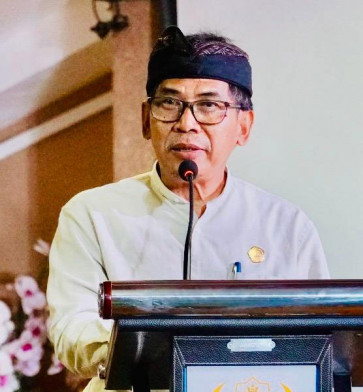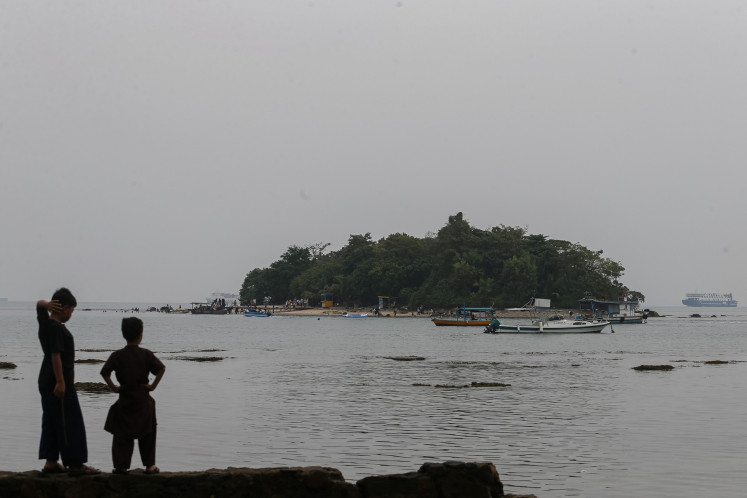Popular Reads
Top Results
Can't find what you're looking for?
View all search resultsPopular Reads
Top Results
Can't find what you're looking for?
View all search resultsBajang Ratu: A sight from the past
Gapura Bajang Ratu, an ancient gateway dating back to the Majapahit era, emanates a captivating charm
Change text size
Gift Premium Articles
to Anyone

Gapura Bajang Ratu, an ancient gateway dating back to the Majapahit era, emanates a captivating charm.
Unlike other historical monuments in Trowulan that stand dignified at soaring heights of more than 20 meters, Bajang Ratu is just 16.5 meters tall.
But what it lacks in grandeur it makes up for in grace. Its slender body is topped with a tiered roof, tapering to some 8 meters, giving it an impression of elegance and exoticism.
The gate's foot has wings adorned with intricate fillets and beautifully crafted relief panels.
Viewed from the driveway, the elegant historical gateway, constructed of brick, reflects distinctive East Java temple architecture.
The monster head of Kala above the doorway is also distinctively East Javanese. All the layers of its tiered roof have relief decorations showing the mystical Garuda bird, dragons and the one-eyed Cyclops.
The antefixes at the corners of its multiple tiered roofs add to its elegance, making this beautiful gateway fit for a king.
As indeed it might have been. Historical records have revealed that Bajang Ratu was constructed 12 years after the demise of King Jayanegara, the third ruler of Majapahit. The name Bajang Ratu has always been associated with Jayanegara, as he was known to have ascended the throne at a very young age. The title "the young King" stayed with him even after his demise.
Although Jayanegara's ashes and bones were buried at Kepopongan village, historical records say that his memorial shrine lies in Trowulan.
Bajang Ratu could be the entrance gate to a larger complex that includes a memorial shrine and possibly a palace at Kraton hamlet in Temon village.
However, a lack of funding prevents further archaeological investigation.
Relief panels at the foot of the gateway, which relate to the folk legend of Sri Tanjung, also point to the existence of a memorial shrine.
The same legend has been found in other temples in East Java. The popular folktale symbolizing the parting of the soul from the flesh tells the poignant story of a woman who is falsely accused of infidelity. It was only after she became a deity that she could prove her virtue and integrity.
Visitors going through Bajang Ratu gate are reminded to pray for a smooth passage for the soul of the deceased and his well-being in the life hereafter.
The wings of this gateway bear a relief telling the legend of Kumbakarna, who died after being attacked by an army of monkeys. Kumbakarna's honor was restored as he stood up for his patriotism.
Subsequent restoration works, the latest being in 1992-1993 at a cost of some Rp 200 million, placed the elegant gateway at the center of a large park. Nevertheless, still more needs to be done to restore Bajang Ratu to its original significance.
Trowulan, the seat of the Majapahit kingdom that flourished through agriculture and trade from the 13th through to the 17th centuries, has left us with a number of heritage buildings that reflect the society's spiritual and social life and the agriculture and blossoming trade relations in the region.
But quite a number of these historical buildings and several individual gravesites are in ruins. Time combined with neglect and vandalism has reduced this precious heritage to just a heap of bricks.
Gentong Temple in Jambu Mente village is an example of this unfortunate situation. It has suffered such severe damage that it is almost impossible to restore it to its original shape. To protect the site from being turned into a housing area, a large tin roof has been erected over the ruins and the area has been declared a heritage site.
But some of those who visit the area believe that the remains of Raden Widjaja, the founder of the Majapahit kingdom, and his three consorts as well as those of a faithful servant are buried in one corner of Gentong Temple.
Although this claim is not backed up by historical data, they insisted that at the gravesites there are headstones bearing inscriptions for them and so walled off one section on the premises of Gentong Temple. A doorway next to a huge banyan tree gives access to the compound with the tombs.
The temple guard here said that the gravesite has seen a steady stream of visitors, adding that visits had become more frequent since the government adopted direct elections.
It is a belief held by many that by visiting and offering prayers at gravesites of prominent persons may see the fulfillment of their wishes for higher positions.









